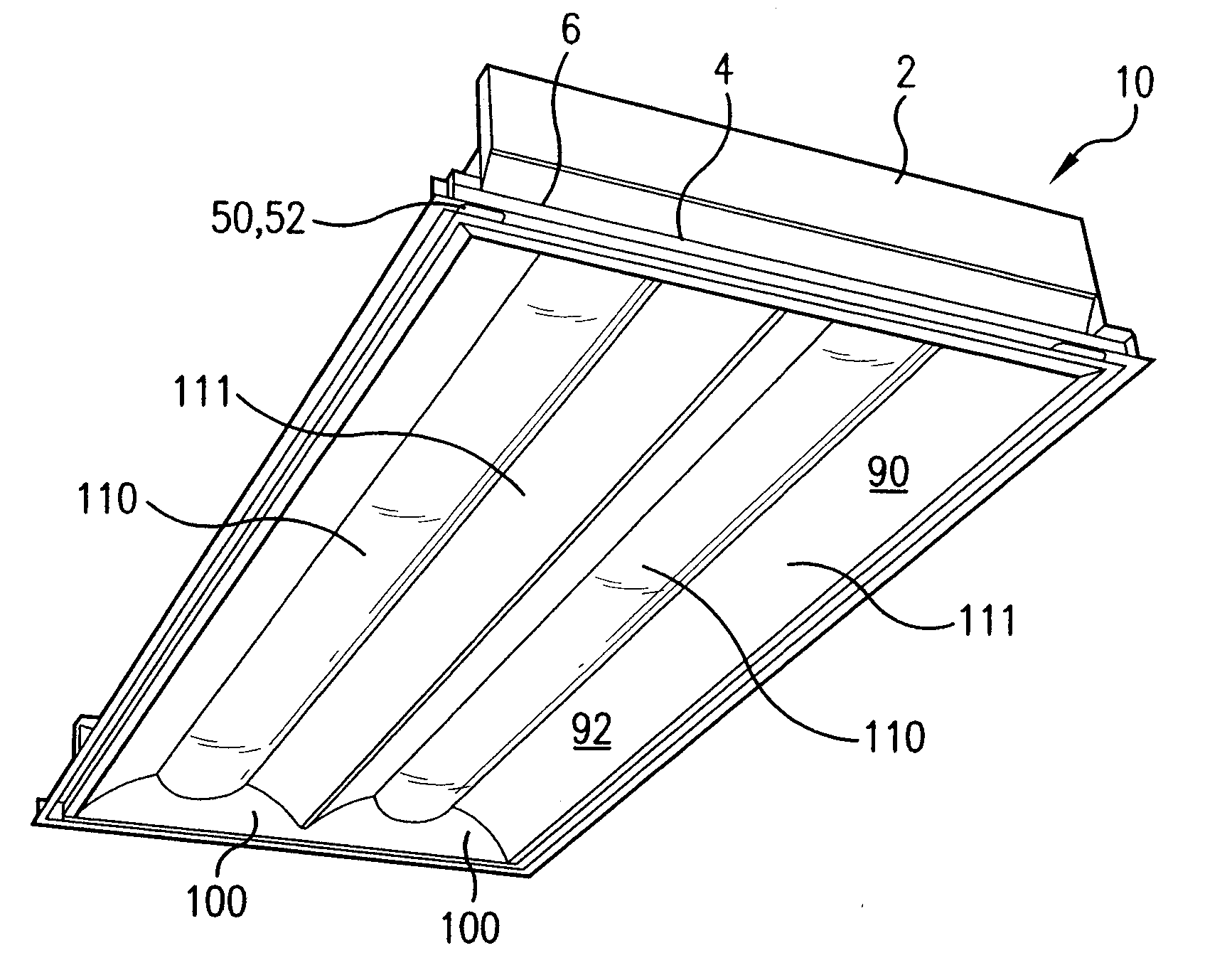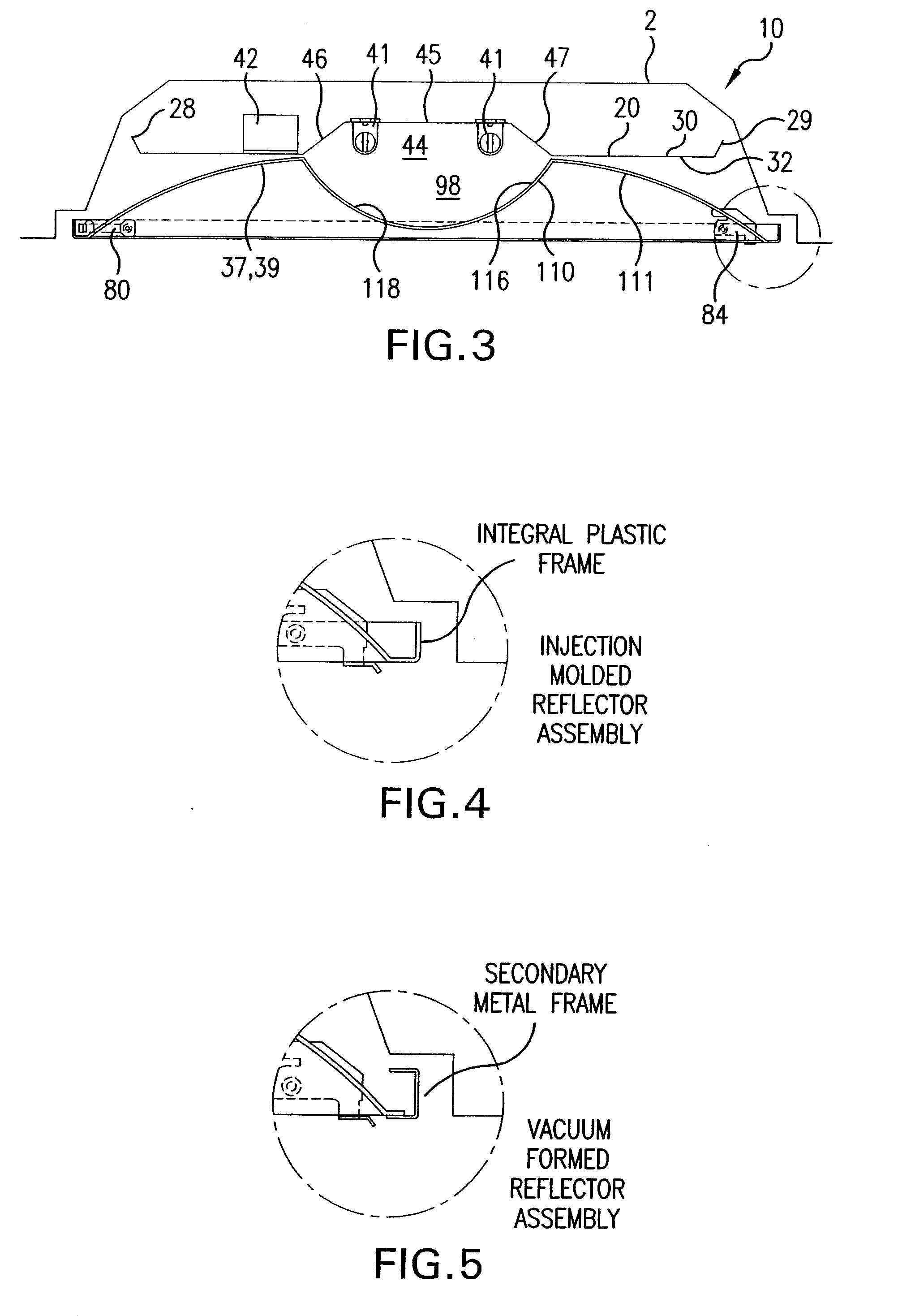Replacement light fixture and lens assembly for same
a technology of replacement light fixture and lens assembly, which is applied in the field of replacement light fixture and a, can solve the problems of large brightness of the surface of the lamp compared to the size of the lamp, the discomfort of employing such lamps, and the severity of the brightness of the lamp. achieve the effect of increasing the light efficiency of the replacement, distributing light relatively uniformly, and reducing the cost of us
- Summary
- Abstract
- Description
- Claims
- Application Information
AI Technical Summary
Benefits of technology
Problems solved by technology
Method used
Image
Examples
first embodiment
[0148]Turning to FIGS. 23 and 25, an exemplary replacement light fixture 200 is illustrated. In this embodiment, the base housing 210 is coupled to the reflector assembly. After the louver, lamps, ballast and ballast cover of the preexisting light fixture are removed, the original, the preexisting lamp fixture housing 2 of the preexisting fixture remains mounted therein the ceiling. In this application, an edge of the base housing of the replacement light fixture is pivotally connected to an edge of the preexisting light fixture housing. In one example, one longitudinal edge of the base housing is pivotally connected, via a hinge, to a longitudinal edge of the preexisting light fixture housing. Alternatively, the respective end edges of the base housing and the preexisting light fixture housing are pivotally connected together. A means of selectively securing the base housing 210 of the replacement light fixture relative to the preexisting light fixture housing 2 is also provided so...
second embodiment
[0150]Referring now to FIGS. 26-28, a replacement light fixture is illustrated. In this exemplary embodiment, the base housing 210 of the replacement light fixture is connected to a portion of a preexisting light fixture housing. In one aspect, the base housing 210 of this embodiment has a first reflector piece 213 that overlies and partially surrounds the light source. The base housing further has a pair of opposing downwardly extending longitudinal side walls 214 that are symmetrically spaced from the longitudinal axis of the base housing. In one aspect, the ballast 42 is mounted to a portion of one of the downwardly extending side walls. In a further aspect, the base housing 210 is mounted to the preexisting light fixture housing such that the base housing extends substantially along the longitudinal axis of the preexisting light fixture housing 2.
[0151]The reflector assembly of the replacement light fixture 200 of this embodiment comprises a pair of opposing, complementary refle...
third embodiment
[0153]Referring now to FIGS. 29-34, the replacement light fixture of the present invention is disclosed. In this embodiment, the base housing 210 defines a pair of longitudinally extending and downwardly facing troughs 215. Each trough is configured to accept a longitudinally extending light source 12. In another aspect, the pair of troughs 215 is substantially parallel to each other. In another aspect, the base housing 210 further comprises a generally planar member 216 that extends between portions of the pair of longitudinally extending troughs 215 so that the longitudinal axis of the troughs are spaced a predetermined distance apart. The base housing 210 is configured to mount to a bottom surface of the preexisting light fixture housing so that the base housing is symmetrically positioned with respect to the preexisting light fixture housing.
[0154]In one aspect, the generally planer member 216 and portions of the opposing troughs 215 define a channel 217 forming an interior cavi...
PUM
 Login to View More
Login to View More Abstract
Description
Claims
Application Information
 Login to View More
Login to View More - R&D
- Intellectual Property
- Life Sciences
- Materials
- Tech Scout
- Unparalleled Data Quality
- Higher Quality Content
- 60% Fewer Hallucinations
Browse by: Latest US Patents, China's latest patents, Technical Efficacy Thesaurus, Application Domain, Technology Topic, Popular Technical Reports.
© 2025 PatSnap. All rights reserved.Legal|Privacy policy|Modern Slavery Act Transparency Statement|Sitemap|About US| Contact US: help@patsnap.com



